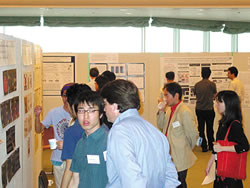"Four Square" at RIKEN: CDB (Kobe)-RCAI (Yokohama)-DRI (Wako) -BSI Joint Retreat
Members from four of RIKEN Research Centers met on May 9th and 10th, 2005 for a research Retreat focusing on biosystems research. Despite the theme, Dr. Maki Kawai, Chief Scientist at the KAWAI Surface Chemistry Laboratory, gave a special lecture titled "Single molecule recognition and reaction: molecules at surfaces" that step outside biology. Participants' response was tremendous. 118 researchers from the four centers came to participate in discussion and exchange.
This event attempted to address requests for increase cooperation and collaboration that are surfacing within RIKEN. This was the first retreat offered by RIKEN that involved more than research centre and it evolved from a Joint Forum Series between BSI and the Kobe Center for Developmental Biology (CDB) that started two years ago. The Yokohama Research Center for Allergy and Immunology (RCAI) and the Wako Discovery Research Institute (DRI) joined researchers from BSI and CDB for this joint retreat at Atagawa Heights hotel in Atagawa on the Izu peninsula. The location was chosen because it is about halfway between Kobe and Wako.
The next joint event will involve members from RIKEN Harima Institute (SPring-8) for the first time. The wide range of fields that will be brought together at the the next RIKEN-wide retreat will foster deeper cooperation within RIKEN.
"Frontiers in Cellular Neuroimaging" Workshop
This workshop (sponsored by BSI Neuronal Circuit Mechanisms Research Group) took place in BSI on June 17th-21st, 2005 and was a great success.
Cellular neuroimaging techniques visualize neuronal and glial activity at the cellular and subcellular levels. These techniques can be applied to isolated brain tissue as well as in vivo conditions and have become increasingly important for neuroscience research. While BSI is a world leader in optical imaging and its researchers have produced many genetically encoded fluorescent probes, no international meeting reflecting BSI's contributions at that level had been organized. Frontier techniques have traditionally been discussed at international workshops at Cold Spring Harbor Laboratory (Cold Spring Harbor, NY, USA) or the Neuroscience Institute of Marine Biological Laboratory (Woods Hole, MA, USA). The "Frontiers in Cellular Neuroimaging" workshop marked the first international event of this caliber at BSI, and quite possibly in Asia.
Dr. Shun-ichi Amari (Director of RIKEN BSI) inaugurated the workshop, which included recognized leaders in the field and young scientists from all over the world. Three of the six Japan-based speakers were BSI principal investigators. In addition to the invited lectures, there were several short talks by selected workshop participants, poster sessions and a round table discussion.
Over seventy people registered for the workshop and with an open door for RIKEN researchers, assured the workshops sessions were well attended, despite the fact that workshop sessions were also scheduled for Saturday and Sunday.
Lecture content was up-to-date and exciting, and many scientists said they found sources of inspiration for their research. The organizers were often asked when the next meeting will be.
This workshop was an coordinated effort of many people including BSPD and members of the Neuronal Circuit and Mechanisms Group. Excellent work by Tommi Látti (audiovisual) and Junko Ogura (registration and support) is specially acknowledged.
Web site:http://www.brain.riken.jp/events/neuroimage/
Symposium: "Unraveling Higher Brain Functions: Recent Progress with Animal Models"
On July 24th and 25th, 2005, BSI's Advanced Technology Development Group (ATDG) sponsored a symposium called "Unraveling Higher Brain Functions: Recent Progress with Animal Models" at Pacifico Yokohama with additional support from the Molecular and Cellular Cognition Society International.
Animal models are indispensable tools in the efforts to understand the molecular and cellular mechanisms of higher order brain function. These models enable a diverse range of analyses that expose molecular, cellular, network and system level activity as well as the interactions between these levels. Individual, social and environmental differences are also observable. As studies involving animal models are complex, cooperation between researchers with different backgrounds and skills is required. Therefore, the goal of this symposium, which was a satellite session of the annual meeting of the Japan Society for Neuroscience, was to establish a network between the current and future animal model researchers as they discussed future research plans and shared ideas.
The symposium opened with a poster session on the 24th that drew about 100 participants for 44 posters. An international group of 12 researchers spoke to 140 people on the 25th. The relaxed atmosphere of the two sessions facilitated candid and enthusiastic exchanges. Dr. Susumu Tonegawa, Group Director of RIKEN-MIT Neuroscience Research Center, wrapped the sessions up in an address to all participants that focused on the importance of developing research methods that exploit the unique characteristics of individual animal species. He also stressed the need to sharpen techniques so that the spatial and temporal qualities of molecular function within the brain, cell, or network being studied could be more precisely revealed.
The number of young participants at this session indicated that the future for scientific research using animal models is solid. Many participants requested that this symposium be offered again.








